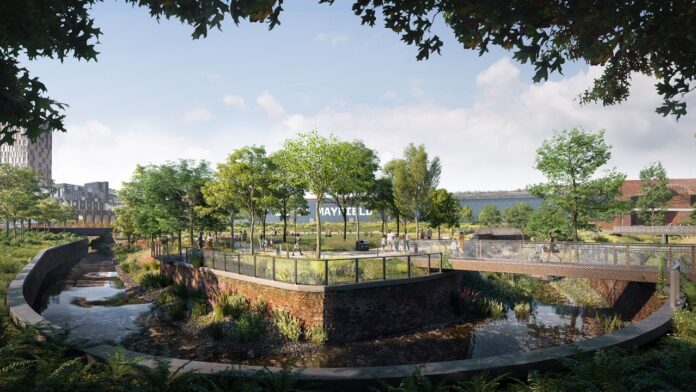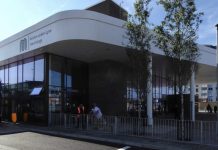A large section of one of Manchester’s founding rivers has been revealed for the first time in more than 50 years, as part of construction of the city centre’s first new public park in a century.
A 365-metre stretch of the River Medlock winds through the huge Mayfield regeneration site adjacent to Manchester Piccadilly Station, but large sections have been buried under concrete culverts for decades.
Now those culverts are being removed, opening up new sections of the Medlock in the first phase of a wider regeneration plan to enrich the river with new wetland planting, generous banks and fast flowing areas. The work will create beautiful green and blue public spaces and new habitats for wildlife in the heart of the city centre.
On Tuesday 25th May, contractors PP O’Connor removed the final sections of a 60-metre concrete culvert at Mayfield. Three of the original steel beams have been retained to create the base of a new bridge over the river, forming part of extensive walkways which will allow Mancunians and visitors to meander through the tranquil new 6.5-acre park when it opens in Autumn 2022.
Removing the culvert not only opens up previously hidden sections of the river to public eyes but will also dramatically improve the natural processes that can occur along that section, by allowing sunlight to reach vegetation that wouldn’t have been able to establish when river was covered over in the early part of the 20th Century when the Baring Street Industrial Estate was built.
The work includes a range of sustainable interventions along the river and its banks which will create new lush green space and add new points of interest.
Bioengineered Coir pallets filled with established wetland plants will be inserted along the Medlock’s banks to provide instant vegetation and new wildlife habitats. The plant species, which include Blue Sedge and Yellow Flag Iris, have been pre-grown in a wetland nursery in Norfolk ready to be planted in Manchester.
Gravels will be installed to help to narrow the Medlock at key points, providing protection from erosion and forming faster flowing areas to oxygenate the water and encourage fish to spawn.
Mayfield Park, designed by masterplanner Studio Egret West, is the centrepiece of the £1.4bn Mayfield redevelopment which is transforming a previously derelict 24-acre part of Manchester’s industrial heritage into a balanced, mixed-use urban neighbourhood.
In 2020, the UK Government pledged £23m of investment from its Getting Building Fund – one of the largest investments in any single project – to Mayfield Park as part of its strategy to support ‘shovel ready’ schemes that will help to drive economic recovery following the COVID-19 crisis.
The scheme is being delivered by the Mayfield Partnership, a public-private venture comprising regeneration specialist U+I, Manchester City Council, Transport for Greater Manchester and developer LCR.
Arlene van Bosch, Mayfield Development Director at U+I, said: “The River Medlock played an incredibly important part in Mayfield’s history – it’s why the famous Dye Works were built here during the Industrial Revolution. As we regenerate this place, it is critical for us that this incredible but largely hidden natural asset should play a part, and be celebrated in Mayfield’s future.
“Removing the culverts is just the start of wide ranging work to resurrect, replant, and restore the Medlock using sustainable materials and approaches to create a healthy river flowing through the centre of Mayfield Park – a welcoming, tranquil accessible public amenity in the heart of Manchester.”
When it is completed, Mayfield Park will provide a range of facilities, including a running track, play areas, riverside walkways, open lawns and a variety of seating options, ensuring all members of the community are catered for and have spaces they can visit and enjoy.
Over 11,000-sq-m of soft landscape – of which 5,000-sq-m is riverside habitat – will create environments to support bird, fish, pollinating insect and bat populations. A diverse planting strategy (including 140 stunning new mature trees of 43 different species), wildflower lawns, shrubs and flowering plants, will also add to the richness of the experience for visitors.
Overall, Mayfield is set to transform a previously derelict part of Manchester’s industrial heritage to deliver 1,500 homes, 1.6m sq ft of market-leading commercial space, 300,000-sq-ft of retail and leisure facilities and 11 acres of new public realm.
The park and new commercial buildings at Mayfield will sit alongside a range of historic buildings, including the landmark former station on Fairfield Street, which are being retained and redeveloped as part of the wider regeneration plans.







